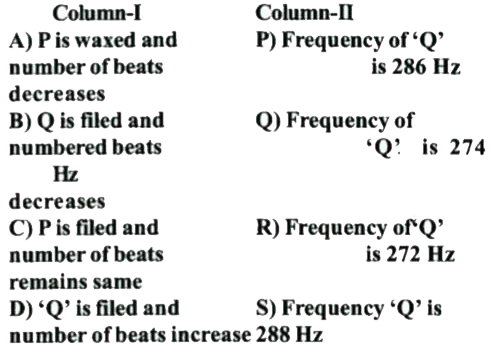A tuning fork A produces 5 beats/sec with another tuning fork B of frequency 256 Hz. If tuning fork A produces 1 beats/sec with some other tuning fork C of frequency 250 Hz, then calculate the frequency of fork A.
The correct Answer is:251 Hz
To find the frequency of tuning fork A, we can follow these steps:
Step 1: Understand the beat frequency concept
The beat frequency is the absolute difference between the frequencies of two tuning forks. If tuning fork A produces 5 beats per second with tuning fork B (which has a frequency of 256 Hz), we can express this as:
|fA−fB|=5
where fB=256Hz.
Step 2: Set up the equations for tuning fork A and B
From the beat frequency condition, we can derive two possible equations for the frequency of tuning fork A:
1. fA=fB+5
2. fA=fB−5
Substituting fB=256Hz:
1. fA=256+5=261Hz
2. fA=256−5=251Hz
Step 3: Analyze the second condition with tuning fork C
Tuning fork A produces 1 beat per second with tuning fork C, which has a frequency of 250 Hz. This gives us another equation:
|fA−fC|=1
where fC=250Hz.
Step 4: Set up the equations for tuning fork A and C
From the beat frequency condition with tuning fork C, we can derive two more equations:
1. fA=fC+1
2. fA=fC−1
Substituting fC=250Hz:
1. fA=250+1=251Hz
2. fA=250−1=249Hz
Step 5: Find the common frequency
Now we have four possible frequencies for tuning fork A:
- From tuning fork B: 261Hz or 251Hz
- From tuning fork C: 251Hz or 249Hz
The only common frequency that satisfies both conditions is:
fA=251Hz
Final Answer
The frequency of tuning fork A is 251Hz.
---
The beat frequency is the absolute difference between the frequencies of two tuning forks. If tuning fork A produces 5 beats per second with tuning fork B (which has a frequency of 256 Hz), we can express this as:
|fA−fB|=5
where fB=256Hz.
From the beat frequency condition, we can derive two possible equations for the frequency of tuning fork A:
1. fA=fB+5
2. fA=fB−5
1. fA=256+5=261Hz
2. fA=256−5=251Hz
Tuning fork A produces 1 beat per second with tuning fork C, which has a frequency of 250 Hz. This gives us another equation:
|fA−fC|=1
where fC=250Hz.
From the beat frequency condition with tuning fork C, we can derive two more equations:
1. fA=fC+1
2. fA=fC−1
1. fA=250+1=251Hz
2. fA=250−1=249Hz
Now we have four possible frequencies for tuning fork A:
- From tuning fork B: 261Hz or 251Hz
- From tuning fork C: 251Hz or 249Hz
fA=251Hz
The frequency of tuning fork A is 251Hz.
Topper's Solved these Questions
- WAVESBOOK - MODERN PUBLICATIONCHAPTER - WAVESEXERCISE - CONCEPTUAL QUESTIONS
25 Videos
- WAVESBOOK - MODERN PUBLICATIONCHAPTER - WAVESEXERCISE - NCERT TEXTBOOK EXERCISES
21 Videos
- WAVESBOOK - MODERN PUBLICATIONCHAPTER - WAVESEXERCISE - PROBLEM
9 Videos
- UNITS AND MEASUREMENTBOOK - MODERN PUBLICATIONCHAPTER - UNITS AND MEASUREMENTEXERCISE - CHAPTER PRACTICE TEST
15 Videos
- WORK, ENERGY AND POWER BOOK - MODERN PUBLICATIONCHAPTER - WORK, ENERGY AND POWER EXERCISE - Chapter Practice Test
16 Videos
Similar Questions
A tunning fork produces 6 beast/s when sounded with a tuning fork of frequnecy 256 Hz. The same tunning fork when sounded with another tunning fork of frequency 252 Hz produces 2 beat/s. Find the frequency of the tunning fork.
View SolutionA tuning fork A produces 4 beat/s with another tuning fork B of frequency 320 Hz. On filing one of the prongs of A, 4 beat/s are again heard when sounded with the same fork B. Then, the frequency of the fork A before filing is
View Solution
Knowledge Check
A tuning fork of unknown frequency x, produces 5 beats per second with a tuning fork of frequency of 250 Hz. The produces 10 beats/second with another tuning fork frequency 265 Hz. The unknow frequency is
A245 HzB255 HzC275 HzD270 HzA tuning fork A produces 4 beats/sec with another tuning fork B of frequency 320 Hz . On filing the fork A , 4 beats/sec are again heard. The frequency of fork A , after filing is
A324 HzB320 HzC316 HzD314 HzA tuning fork X produces 4 beats/sec with a tuning fork Y of frequency 384 Hz. When the prongs of X are slightly filed 3 beats/sec are heard. What is the original frequency of X ?
A388 HzB381 HzC380 HzD387 Hz
A tuning fork A of frequency f gives 5 beats/s with a tuning fork B of frequency 512 Hz. If on filing A, the number of beats remains same, then find the value of f.
View SolutionA tuning fork A produces 4 beats/second with another tuning fork of frequency 246 Hz. When the prongs of A are filed a little, the number of beats heard is 6 per second. What is the original frequency of the fork A?
View SolutionA tuning fork gives 5 beats with another tuning fork of frequency 100 Hz . When the first tuning fork is loaded with wax, then the number of beats remains unchanged, then what will be the frequency of the first tuning fork
View SolutionA tuning fork A produces 4 beats/ s with tuning fork, B of fequency 256 Hz. When the fork A is filled beats are found to occurs at shorter intervals, then the original frequency will be
View SolutionA tuning fork 'P' of frequency 280Hz produces 6 beats/s with unknown tuning fork 'Q'

View Solution
